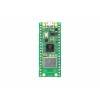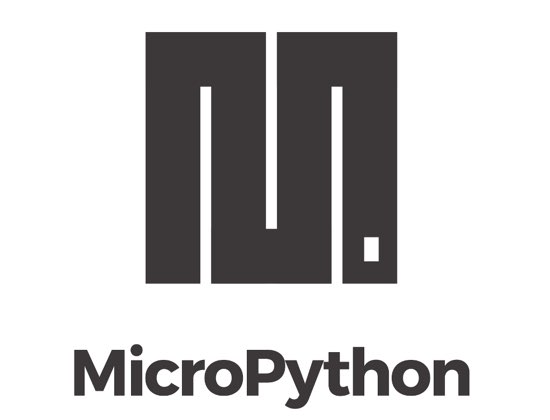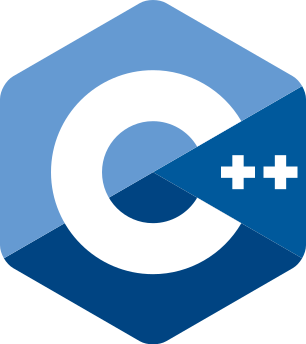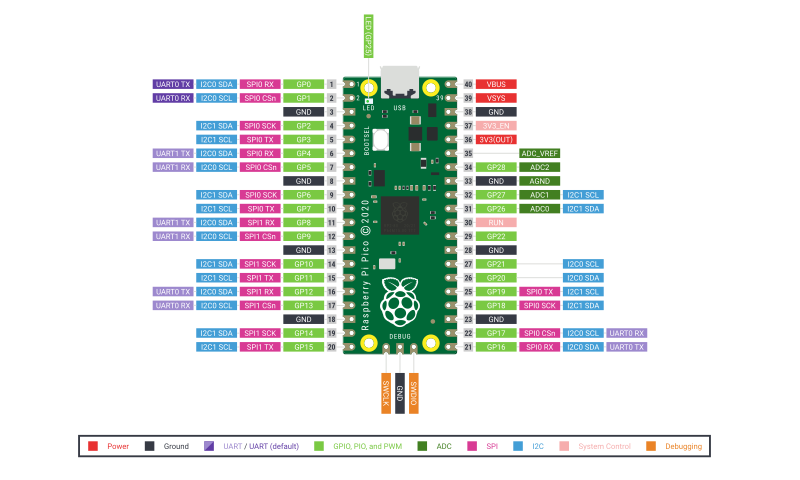



zł27.40 tax excl.
The board with the RP2040 microcontroller equipped with two ARM Cortex-M0 + cores operating at a frequency of 133 MHz, 264 kB RAM. The board also has 2 MB of QSPI flash memory. In addition, the board is equipped with the Infineon CYW43439 system, extending the board with wireless connectivity. Version with soldered connectors. Raspberry Pi SC0919
The Raspberry Pi Pico is the first board to feature a microcontroller designed by the Raspberry Pi foundation. The chip that is the heart of this board has been equipped with two ARM Cortex M0+ cores operating at a frequency of 133 MHz, 256 KB of RAM and 30 GPIO ports. The microcontroller itself is not equipped with flash memory, but on the board there is an external memory with a capacity of 2 MB connected via the QSPI interface. In addition, the board is equipped with the Infineon CYW43439 system, extending the board with wireless connectivity. The module provides WiFi connectivity in the IEEE 802.11 b / g / n standard. The platform supports the popular MicroPython and C/C++ programming languages. Programs can be uploaded to memory via the USB interface in mass storage mode or by using an external programmer that supports the SWD interface.

Kamami is the official distributor of Raspberry Pi minicomputers and dedicated accessories.

MicroPython is a special version of the Python 3 programming language, prepared to run directly on embedded systems such as the Raspberry Pi Pico. The version prepared especially for the RP2040 microcontroller, supports REPL, an interactive shell that allows you to execute scripts, typing into the console and viewing the results of the program in it. Thanks to this technology, it is also possible to save the program in flash memory.
To facilitate the programming of the RP2040 microcontroller in C / C ++, the Raspberry Pi Foundation has prepared an official SDK toolkit that can be integrated with popular IDEs such as Visual Studio Code or Eclipse. The entire environment configuration process is described in the Getting started with Raspberry Pi Pico document.


The Raspberry Pi Pico can be programmed via the USB interface, it can be done in two ways.
The first is the USB mass storage mode, to program the board in this way, press and hold the BOOTSEL button, and then connect the board to the computer with a USB cable. The device will be recognized as mass memory to which you can upload the program in the same way as copying files to a pendrive. After uploading the program, the microcontroller will automatically reset and start the uploaded program. This method is suitable for uploading programs written in C / C ++ or for uploading the MicroPython interpreter.
The second way works only with programs written in MicroPython and requires prior loading of the interpreter using the first method. This method consists in saving the program layout transferred with REPL in the memory.
When programming in C/C++, there is often a need to repeatedly test the program. Loading a program via USB requires repeating the procedure every time, disconnecting the board from the computer, pressing the button and connecting the board, and then finding the compiled program and copying it to memory. The whole thing takes quite a long time, but fortunately it can be simplified using an external programmer with SWD interface. Programming via SWD is much faster, you only need to connect the programmer once with a 3-pin connector and power supply e.g. via USB and you can upload programs directly from the IDE. In addition, you can debug the program in this way and efficiently find any errors in the code by running it line by line.
The Raspberry Pi Pico is designed to be programmed directly with the Raspberry Pi 4B or 400. The manufacturer has prepared detailed instructions for setting up programming environments and ready-made configuration scripts. Pico can be programmed from the Raspberry minicomputer both via USB and via SWD. The big advantage of this solution is no need to use an external SWD programmer. Pico ports can be connected to RPI ports. To ensure a stable connection, you should connect Pico directly to the minicomputer, the use of the contact plate may introduce interference.
To use the full potential of programming environments, it is recommended to use minicomputers with min. 4 GB of RAM.
The Raspberry Pi Foundation has prepared the Picoprobe application that allows you to change RPI Pico into an SWD programmer and a USB - UART converter. Thanks to this, you can program the RP2040 without the need for an SWD programmer, using only the second board with the RP2040 microcontroller.
Warning!
The Raspberry Pi Pico board does not include goldpin connectors and a microUSB cable. Our offer includes connectors for GPIO 1x40 (they can be easily divided into two 1x20 connectors) and a connector 1x3 for a programmer. There are also ready-made kits containing connectors and microUSB cable.

Data sheet
Manufacturer BTC Korporacja sp. z o. o. Lwowska 5 05-120 Legionowo Poland sprzedaz@kamami.pl 22 767 36 20
Responsible person BTC Korporacja sp. z o. o. Lwowska 5 05-120 Legionowo Poland sprzedaz@kamami.pl 22 767 36 20
Universal board equipped with a metalized hole grid with a pitch of 2.54 mm, enabling mounting using goldpin strips or directly on the surface, with markings facilitating the identification of signals
Compact development board based on the Raspberry Pi RP2350 microcontroller, equipped with two cores (ARM Cortex-M33 and Hazard3 RISC-V), 520KB RAM and 2MB Flash, ideal for IoT, smart home and wearable projects. With 11 IO pins, battery charging support, C/C++/MicroPython/Arduino programming and SMT support, it is perfect for rapid prototyping and mass production. DFRobot DFR1188
The RP2040 microcontroller board features two ARM Cortex-M0+ cores that operate at 133 MHz. It has 264 kB of RAM, and the board also includes 16 MB of QSPI Flash memory. The chip can be programmed in C/C++ or MicroPython. Waveshare RP2040-Plus-16MB
RP2350-LCD-1.28 is an advanced, compact development module with a color LCD display and a rich set of interfaces, designed for embedded projects that require efficient graphics handling and communication. Thanks to its dual processor architectures and programmable peripheral resources, the module is suitable for use in smart devices, HMI systems, and next-generation IoT solutions.
Mechanical keyboard module with LED backlight, encoder and display. Based on the RP2040 microcontroller. Adafruit 5100
Starter kit containing Raspberry Pi Pico, necessary connectors and a microUSB cable. The kit is recommended for people programming in MicroPython
No product available!
Development board with RP2040 microcontroller. Equipped with a driver for DC motors, servos and Grove connectors. Dedicated to the construction of robots. Cytron MAKER-PI-RP2040
Expansion module with a Raspberry Pi Pico W board equipped with WiFi communication. The module has a built-in relay, buffer inputs, sink outputs and analog inputs. Perfect for controlling fans, pumps, solenoid valves, large motors, electronic locks or LED lighting. Pimoroni PIM652
RP2350B-Plus-W is an advanced development board with an RP2350B microcontroller and wireless Wi-Fi/Bluetooth communication, enabling selection between ARM and RISC-V architectures. Intended for educational applications, IoT device prototyping, and projects requiring versatile communication and processing capabilities.
No product available!
RP2350-Touch-AMOLED-1.43 is a high-performance platform for building modern user interfaces in mobile, wearable, and control system projects. The high-contrast AMOLED display and capacitive touch, combined with an IMU sensor and RTC, provide a comprehensive development environment for applications requiring advanced interaction and mobility.
Waveshare RP2350-One is a compact development board featuring the RP2350A microcontroller with dual-core architecture: Arm Cortex-M33 and RISC-V. It offers a rich set of peripherals and 4 MB of Flash memory. With a direct USB Type-A connector, support for C/C++ and MicroPython, and SMT mounting capability, it is ideal for modern embedded applications, automation, and technical education.
No product available!
USB RTC module based on Raspberry Pi RP2040 microcontroller. It combines MicroSD card slot, LCD display and CR1220 battery holder. SB Components SKU25138
Module with a 2.9" ePaper display and a Raspberry Pi Pico W board equipped with WiFi communication. It has a built-in Qwiic/Stemma QT connector with an I2C interface, buttons and a battery connector. Perfect as a display for a weather station. Pimoroni PIM669
MicroMod main module with RP2040 microcontroller. Equipped with an M.2 connector, it can work with MicroMod expansion boards. SprakFun DEV-17720
A module based on the RP2040 microcontroller that lets you build your own two-player arcade controller, supporting up to 30 buttons and two joysticks. When connected via USB-C, it is automatically detected as a standard game controller on PC, Mac and Linux. With DuPont, Qw/ST connectors and support for backlit Plasma buttons, assembly and expansion are quick and solderless. Pimoroni PIM741
RP2350-USB-A is a versatile development board based on the modern RP2350A microcontroller with a unique dual-core architecture: Arm Cortex-M33 + RISC-V. Thanks to the USB Type-A port supported via PIO, a wide range of interfaces, and a compact form factor, the board is ideal for prototyping peripheral devices, learning programming, and integrating into custom projects as an SMD module.
The board features the Raspberry Pi Foundation\'s RP2040 microcontroller and the WizFi360 module, which provides 2.4GHz WiFi communication over 802.11 b/g/n. WIZnet WizFi360-EVB-Pico

The board with the RP2040 microcontroller equipped with two ARM Cortex-M0 + cores operating at a frequency of 133 MHz, 264 kB RAM. The board also has 2 MB of QSPI flash memory. In addition, the board is equipped with the Infineon CYW43439 system, extending the board with wireless connectivity. Version with soldered connectors. Raspberry Pi SC0919
